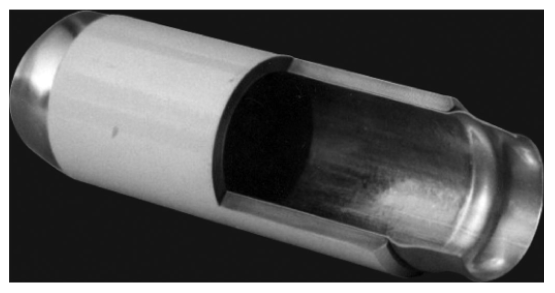1. Types of submarine pipelines
According to the material composition, the submarine pipelines are generally divided into carbon steel pipes and corrosion-resistant alloy composite pipes. For the exploitation of highly corrosive oil and gas fields, traditional single anti-corrosion technologies and materials such as adding corrosion inhibitors, using plastic inner coatings, and corrosion-resistant alloys are difficult to balance in terms of reliability of corrosion resistance and economic indicators; it is difficult to meet the needs of the development of oil and gas fields. To reduce the production cost and prolong the service life of the pipeline, the use of a bimetal composite pipe is one of the relatively safe and economical ways to solve the corrosion in high H2S or CO2 oil and gas fields.
Bimetallic composite pipes use corrosion-resistant alloy pipes, using stainless steel and nickel-based alloys as the inner lining, and carbon steel pipes as the outer base pipe. The inner lining has good corrosion resistance, and the base pipe has excellent mechanical properties, so that the bimetallic composite pipe can achieve the same corrosion resistance as the inner lining pipe, which improves the safety level of the pipeline and prolongs the service life of the pipeline. Because the corrosion-resistant alloy pipe reduces the amount of corrosion-resistant alloy, the cost of the pipe is only 1/5 to 1/2 of the pipe made from pure corrosion-resistant alloy.
1.1 Carbon steel pipes
Carbon steel pipes can be divided into three types according to different manufacturing processes, including seamless steel pipes (SML), high-frequency electric resistance welded steel pipes (HFW), and submerged arc welded steel pipes (SAW). Seamless steel pipes are manufactured by thermoforming processes, and there are two heat treatment methods, that is normalizing state and quenched and tempered state. The pipe diameter generally ranges from 4 inches to 30 inches; the steel grade is generally below API 5L PSL2 X70, and the wall thickness generally ranges from 5mm to 50mm. High-frequency electric resistance welded steel pipe is manufactured from strip forming with a longitudinal welding seam formed by a welding process without filler metal. Longitudinal welding seams are formed by induction or conduction of high-frequency currents (minimum 100kHz). The welded area or the entire tube is to be heat treated. The pipe diameter generally ranges from 4 inches to 26 inches, the steel grade is generally below API 5L PSL2 X80, and the wall thickness generally ranges from 5mm to 16mm.
The submerged arc welded steel pipe is manufactured by forming a steel strip or steel plate, and has a longitudinal welding seam formed by the submerged arc welding process, with at least one welding seam on the inside and outside of the pipe. Continuous or intermittent single-run tack welding by gas metal arc welding is permitted. According to the different forming processes, the submerged arc welded steel pipe is divided into UOE, RBE and JCOE. The pipe diameter generally ranges from 24 inches to 40 inches; the steel grade is generally below API 5L PSL2 X80, and the wall thickness generally ranges from 8mm to 25mm. Seamless steel pipes, high-frequency electric resistance welded steel pipes, and submerged arc welded steel pipes are widely used in submarine pipeline engineering. At present, the ranking of quality of carbon steel pipes for submarine pipelines in engineering applications is seamless steel pipes, submerged arc welded steel pipes, and high-frequency resistance welded steel pipes.
1.2 Corrosion-resistant alloy composite pipes
Corrosion-resistant alloy composite pipes can be divided into two types, mechanical composite pipes and metallurgical composite pipes according to different manufacturing processes.

Figure1 Basic structure of corrosion-resistant alloy composite pipes
A mechanical composite pipe refers to a new type of pipe that combines two different metal pipes through mechanical manufacturing processes such as hydraulic expansion, elastomer extrusion, or explosion. It fully combines the high strength of the base pipe with the excellent corrosion resistance of the liner. The manufacturing principle of the mechanical composite pipe is that the corrosion-resistant alloy steel pipe is inserted into the carbon steel pipe; superimpose the two pipes coaxially, and expand the inner pipe and the outer pipe at the same time through hydraulic expansion or explosion, and the inner pipe undergoes great plastic deformation. The outer tube has a small elastic deformation. After the pressure is released, the elastic deformation of the inner and outer tubes recovers, and the two tubes are well combined. The end of the subsea pipeline is usually surfacing to weld the inner lining and the carbon steel pipe, so that a closed space is formed between the layers, and a complete anti-corrosion surface is formed inside the pipeline.
There are two manufacturing methods for metallurgical composite pipes. One is to combine carbon steel and corrosion-resistant alloy steel through the hot rolling process to make composite steel plates, and then make the composite steel plate into seamless pipes or straight seam welded pipes; the other one is to directly combine the corrosion-resistant alloy steel with the carbon steel pipe material by surfacing welding to form a corrosion-resistant metallurgical composite pipe.